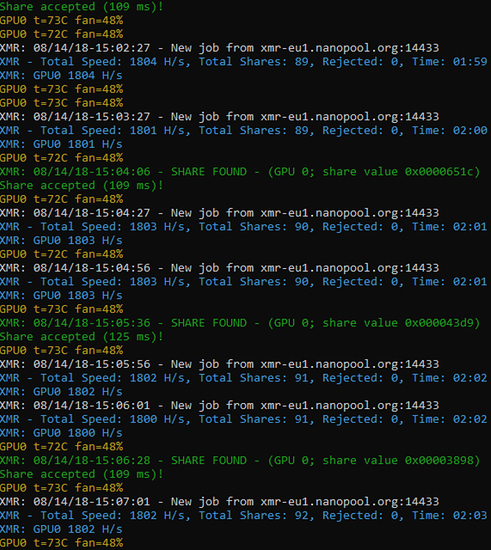So I’ve been mining Monero for a couple of days on that RX Vega 56 and the web interface of nanopool suggests I’m not mining at a steady rate. The miner on the other hand reports solid 1800H/s. Is this normal?
TLDR: yes
The miner displays the actual number of hashes/second your card computes. The pool cannot directly verify that number however. If the pool were to blindly believe the hashrate reported by your PC people would obviously abuse this and report higher numbers than they actually achieve.
To solve this your miner has to find “shares”. Just like finding the correct block shares require guessing some special number. (They are much, much easier to find though.) If your machine guesses two correct numbers in short order the website thinks that your miner is faster than it actually is. If on the other hand you get unlucky and don’t find a share for a while the website thinks you are mining slower than you really are. The effects average out over time.
what miner are you using
but yes, law of averages and number inflation on closed source minors are both factors
xmr-stak
Half a year Monero miner here. Have a Vega 64 Doing ~2010H/s
1.
Best there is miner (optimized for Vega):
Cast-xmr: http://www.gandalph3000.com/
2.
pool that makes a free transaction at a given quantity:
mineXMR: https://www.minexmr.com/
3.
and you need a wallet to link it in the pool.
4.
When you got that setup you will need on every reboot to disable the GPU and re-enable (ofc blockchain drivers have to be used).
5.
DL and run OverdriveNTool https://forums.guru3d.com/threads/overdriventool-tool-for-amd-gpus.416116/
6.
Use these settings:
GPU: P7 1407 mV 870
Memory: P3 1100 mV 850
Fan: Minimum 2861 Maximum 4900 Target temp. 75
If you need anything else ask. I have this shit figured out.
the people that make cast have been caught inflating the reported hashrates a bit
Where the hell did you got that. Not that I don’t believe you it’s just I didn’t find anything on the net.
A few pros over the others it constantly shows hashrates it doesn’t drop as much more stable at least for me and the fee is lower.
I used to work in large rig maintenance, there’s a lot that goes on like that behind the scenes. It’s actually fairly common practice, claymore did the same thing on earlier versions of their miner.
when you think about it it’s a great marketing tactic, if you use a moving average on reporting hashrates the user doesn’t see drops, if you round up or give it a base bump then it looks like the software is faster and more reliable.
Your post about the RX VEGA 56 and its Ethereum mining performance caught my attention. It’s always exciting to optimize mining rigs and get the most out of our hardware. Regarding your setup, have you checked your GPU settings and power limit? Sometimes tweaking those can help improve mining performance. Also, make sure you have the latest drivers and firmware for your GPU.
Surprised GPU mining is still a thing.

